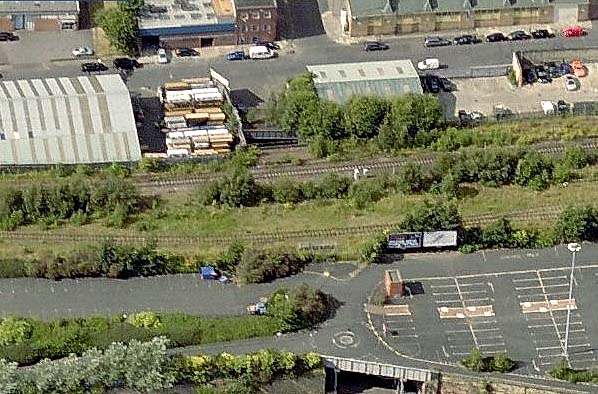
Station Name: NEWCASTLE (N & C 1st site)
|
| Date opened: | 21.10.1839 |
| Location: | Railway Street, near junction with Tyneside Road |
| Company on opening: | Newcastle & Carlisle Railway |
| Date closed to passengers: | 1.3.1847 |
| Date closed completely: | 1.3.1847 |
| Company on closing: | Newcastle & Carlisle Railway |
| Present state: | Demolished |
| County: | Northumberland |
| OS Grid Ref: | NZ238633 |
| Date of visit: | July 1962 |
|
Notes: The temporary Newcastle terminus of the railway from Carlisle was located at was then the edge of the city’s built-up area. The first passenger trains used the station on 21 May 1839 for a special inaugural trip, and regular services commenced five months later. Sources refer to this station as ‘at Shot Tower’ and ‘Railway Street’. Simple wooden structures were provided at the station, which closed when the line was extended into the centre of Newcastle. (Collard’s map of 1841 ‘jumped the gun’ in showing the station further east at the Infirmary, a short distance south west of Central station. For some time this was the intended terminus of the line: see Fawcett [2008] p103-6). The Newcastle (or, more accurately, Gateshead) to Carlisle line was the first to cross the breadth of England from the east to the west coast. Horse-drawn goods trains commenced between Blaydon and Hexham in late-1834, and passenger services on 9 March 1835. Newcastle passengers were conveyed to and from Blaydon by horse-omnibus or boat. Steam locomotives hauled passenger trains from the opening day. On 11 June 1835 a 1¼ mile extension opened eastwards to Derwenthaugh, followed by 7½ miles from Hexham to Haydon Bridge on 28 June. Carlisle to Blenkinsopp Colliery, near Haltwhistle (20 miles), opened on 19 July 1836. On 1 March 1837 trains were introduced on the 2½ miles from Derwenthaugh to Redheugh (Gateshead), passengers being ferried by steamboat across the Tyne to a ‘station’ in Newcastle at No. 66 The Close, where the later High Level Bridge crossed the river. (The Close was one of a scarce breed of rail-less stations in Britain, others being Dartmouth and Hull Corporation Pier.)
The omnibus service from Blaydon to Newcastle continued; its terminus in Newcastle was at an office at 50 Westgate Road. The gap between Blenkinsopp and Haydon Bridge was eventually completed, allowing directors to travel between Redheugh and Carlisle (London Road) on 15 June 1838. The formal opening was on 18 June. This event was less than successful; heavy rain drenched the passengers, and many were left shaken, and some injured, by two collisions. N&CR rails reached Newcastle via a three-mile route including a ‘temporary’ Tyne bridge at Scotswood (which was eventually replaced with the present structure in 1870). Formal opening to a station at Railway Street, close to the Shot Tower, took place on 21 May 1839; regular services began on 21 October. The new Forth terminus, replacing that at Railway Street, opened on 1 March 1847. From 1 January 1851 the company used Newcastle Central, shared with the York, Newcastle & Berwick Railway. Although access to Carlisle Citadel had yet to be achieved, the 60½-mile route was complete. The Newcastle & Carlisle was absorbed into the North Eastern Railway empire in July 1862. Its eccentric arrangement of right-hand running was discontinued after the re-signalling of the route for the standard left-hand operation in 1863-4. In the 1960s the transformation of the townscape surrounding the railway between Newcastle and Blaydon began. Many of the terraces of two-storey Tyneside flats were demolished and high-rise blocks took their place, and more recently the Elswick works site has been all but cleared and redeveloped as a business park. On 4 October 1982 passenger services ceased to use the Newcastle – Scotswood – Blaydon route. Trains were diverted from Newcastle West Junction over King Edward Bridge, then via Norwood Junction and Dunston to Blaydon. This alteration saved expenditure on maintaining Scotswood Bridge, and on points and crossings renewals at Blaydon and Newcastle West Junction. Tracks were removed from Scotswood Bridge and eastward beyond Elswick, leaving only a one-mile siding from Newcastle. The diversion added four minutes to journey times. On the new route the intermediate station at Dunston (closed 1926) was reopened in 1984, but for some years has enjoyed only a token service. The Metro Centre is adjacent to this route, and its station (opened in 1987) provides additional passenger traffic. Between Elswick and Scotswood the track is now a cycleway and footpath known as Hadrian's Wall Path, part of an 84 mile national trail.Tickets from Michael Stewart Sources:
To see other stations on the Newcastle - Blaydon click on the station name: Newcastle (N & C 2nd site), Elswick, Scotswood Works Halt, Scotswood & Blaydon |


This is a simulated map showing the position of the first Newcastle Station.
 Home Page
Home Page | Last updated: Sunday, 21-May-2017 16:01:53 CEST |
© 1998-2009 Disused Stations
|
